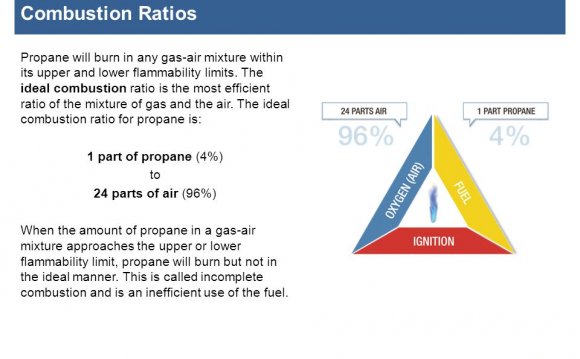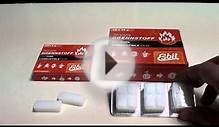
Stable and efficient combustion conditions require correct mixtures of fuels and oxygen
Stable combustion conditions requires the right amounts of fuels and oxygen. The combustion products are heat energy, carbon dioxide, water vapor, nitrogen, and other gases (excluding oxygen). In theory there is a specific amount of oxygen needed to completely burn a given amount of fuel. In practice, burning conditions are never ideal.
Therefore, more air than ideal must be supplied to burn all fuel completely. The amount of air more than the theoretical requirement is referred to as excess air.
Power plant boilers normally run about 10 to 20 percent excess air. Natural gas-fired boilers may run as low as percent excess air. Pulverized coal-fired boilers may run with 20 percent excess air. Gas turbines runs very lean with up to 300 percent excess air.
Typical values of excess air for some common fuels are shown in the table below:
| Fuel | Excess of Air
(%) |
|---|---|
| Anthracite | 40 |
| Coke oven gas | 5 - 10 |
| Natural Gas | |
| Coal, pulverized | 15 - 20 |
| Coal, stoker | 20 - 30 |
| Oil (No. 2 and No. 6) | 10 to 20 |
| Semi anthracite, hand firing | 70 to 100 |
| Semi anthracite, with stoker | 40 to 70 |
| Semi anthracite, with traveling grate | 30 to 60 |
To determine the excess air at which the combustion system will operate we have to start with the stoichiometric air-fuel ratio, known as the perfect or ideal fuel ratio, the stoichiometric combustion. During stoichiometric combustion there is a chemically correct mixing proportion between the air and the fuel. During the stoichiometric combustion process no fuel or air are left over.
Process heating equipment almost never runs stoichiometric. Even so-called "on-ratio" combustion, used in boilers and high temperature process furnaces incorporates a modest amount of excess air - 10 to 20% more than needed to burn the fuel completely.
If insufficient amount of air is supplied to the burner, unburned fuel, soot, smoke, and carbon monoxide are exhausted from the boiler. The results is heat transfer surface fouling, pollution, lower combustion efficiency, flame instability and a potential for explosion. To avoid inefficient and unsafe conditions, boilers normally operate at an excess air level. This excess air level also provides protection from insufficient oxygen conditions caused by variations in fuel composition and "operating slops" in the fuel-air control system.
Tag Search
- en: fuels combustion effeciency air excess optimal
RELATED VIDEO












